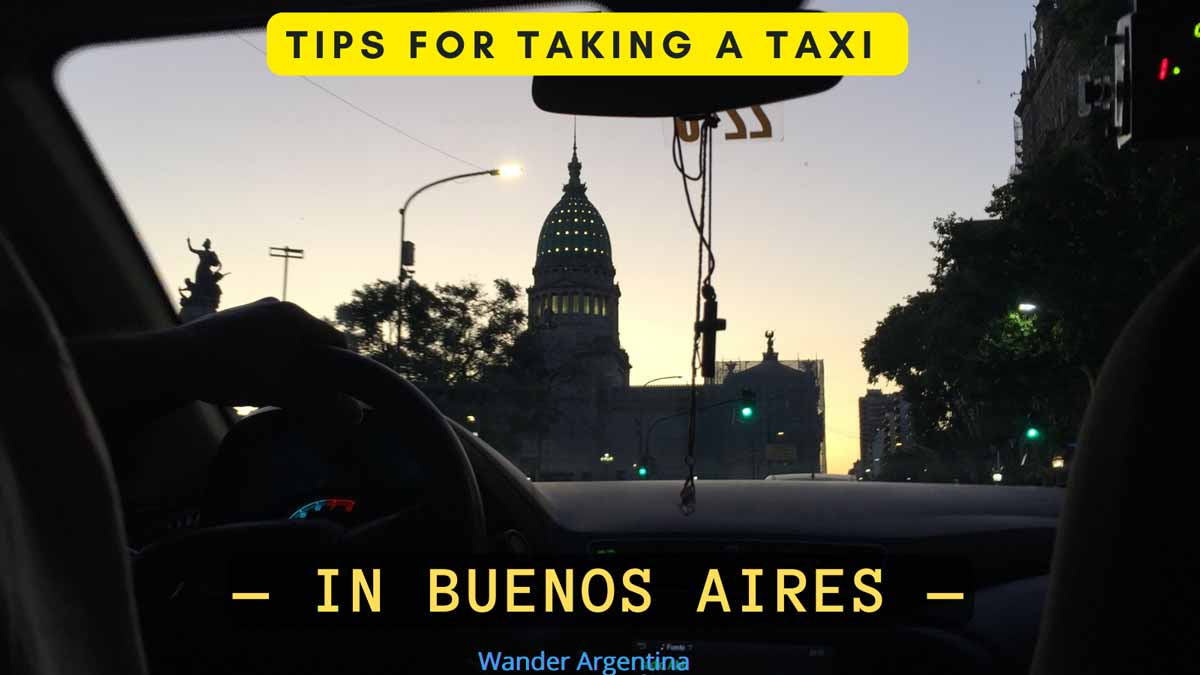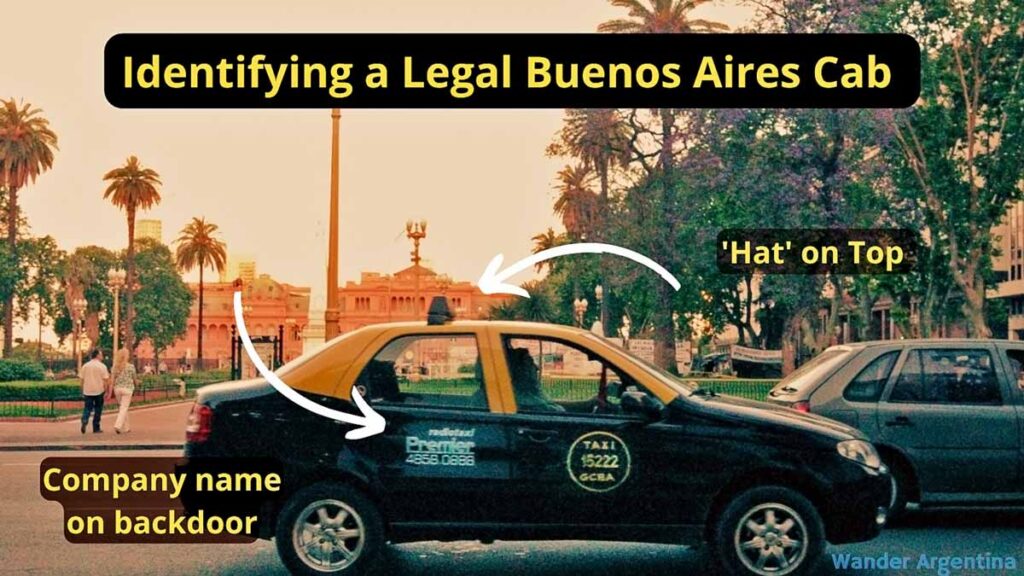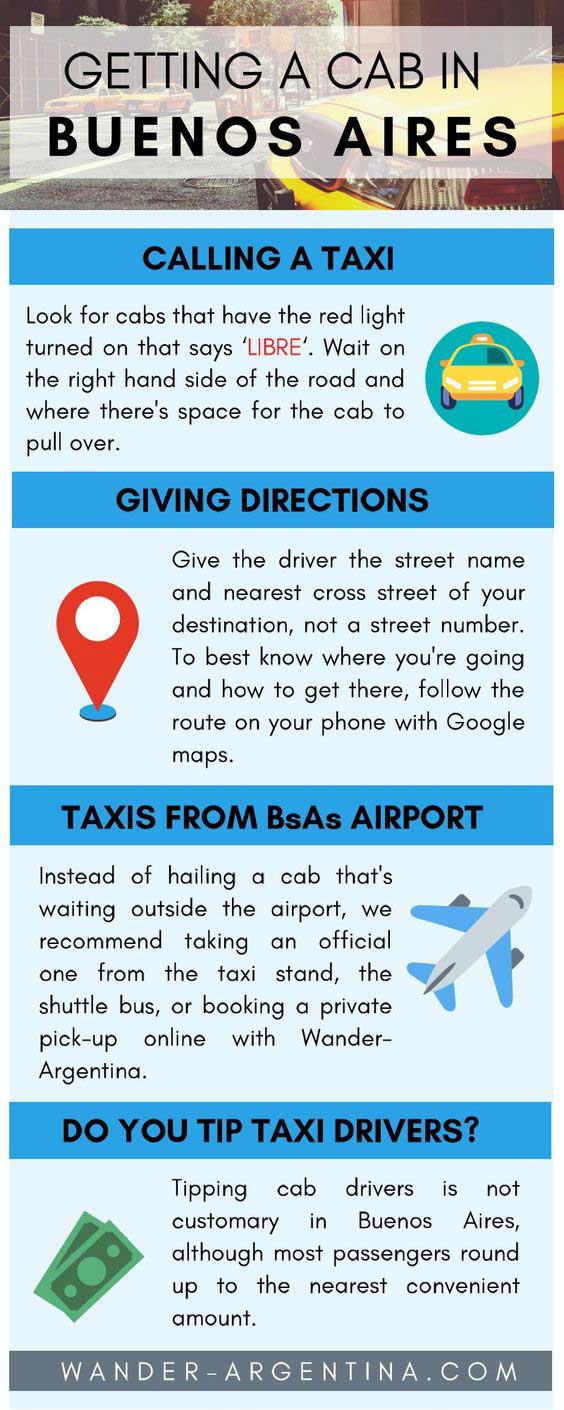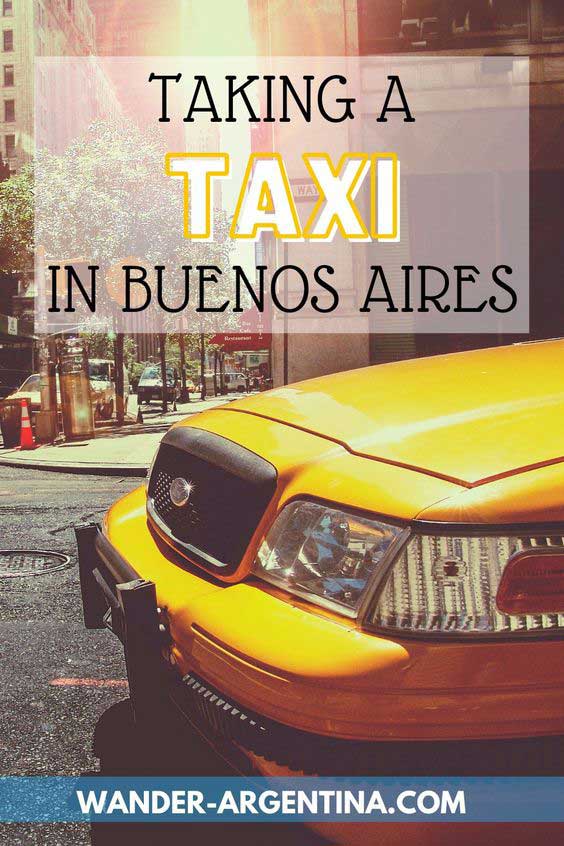Taxis are abundant in Buenos Aires with its almost 40,000 cabs, is one of the best cities in the world to easily get a taxi.

The black and yellow cars abound — there is one car for every 80 inhabitants.
Thanks to the favorable exchange rate, they are a great value and it’s easy to hail a cab on any major avenue, rain or shine.
The only time it is difficult to get a taxi in central Buenos Aires is when the subway or the bus lines shut down due to protests or flooding and all the wayward passengers decide to hail a taxi cab at the same time.
Table of Contents
Buenos Aires How To: Hailing or Calling a Taxi
To summon a taxi on the street, look for cabs that have the red light turned on that says ‘LIBRE‘ in the corner of the windshield.
Stand on the right-hand side of the avenue and try to select a place where the taxi will have room to stop safely.
Make sure not be standing in the way of a bus stop or bike lane.

When there’s lots of traffic or a protest blocking streets, the Buenos Aires Metro is a faster option.
Learn how to take the subway ➡
Giving Directions to Taxi Drivers
The most common way locals give directions to taxi drivers is to name the street and the nearest cross street of their destination, rather than a street number.
Feel free to suggest a preferred route to the driver.
Even if you don’t know the exact route, you can at least pretend that you do.
Often the driver will ask you whether you want to take one street or another.
He may ask, for example, “¿Corrientes o Rivadavia?”
Instead of saying that you don’t know, answer with a firm, “Corrientes!”
The two routes are likely to be fairly similar in distance so the price won’t change much if you choose the longer option. You will give the impression that you know your way around, and he’s less likely to take you on a ‘gringo tour‘ (which can happen to any traveler, no matter their nationality.)
It’s also easier to tell the driver, “Vamos hasta Uruguay y Santa Fe” (Let’s go to the corner of Uruguay and Sante Fe Streets), rather than saying, “Uruguay 1245.”
Naming the cross streets instead of stating the address also leaves less room for economically-motivated ‘confusion.’
Once you give directions and are on your way, make sure the taxi driver turns on the meter. If they refuse to for some reason, request they stop so you can get out and hail another cab.
In Buenos Aires the meter increases every 200 meters or 30 seconds of idle waiting time.
While most of the taxi drivers of Buenos Aires are honest, occasionally a cab driver may take a route that seems illogical or drive you into the middle of a traffic jam.
Part of his act will be to appear incredulous — like he had just no idea that a protest would be blocking the street, even though he’s currently blaring the news on the radio.
The more one knows Buenos Aires, where they’re going and how to get there, the less this will happen.
Those who have a data plan for their phone can track the ride on Google Maps to make sure there are no large detours.
Riders should be aware that there are many one-way streets in Buenos Aires and left turns aren’t usually permitted, so sometimes it is more convenient to just get out and walk half a block near your destination instead of waiting for the cab driver to go around the whole block.
If your Argentine Spanish is up to par you will find Buenos Aires many cab drivers to be rather entertaining and opinionated conversationalists — get them going about football or politics for a good laugh, or to learn some new Lunfardo.
The vast majority of taxis in Buenos Aires only take cash, but the newish app rolled out by the city called BA Taxi allows users to request a taxi through their smartphone and pay with a credit card (but keep in mind you will get the lower MEP rate.)
Unfortunately, the BA Taxi is app is only available in Spanish and has poor reviews on Google Play and the App Store.
As an alternative, Uber and other ride sharing have caught on, many foreigners find them easier to navigate if one doesn’t speak Spanish.
Official Taxis vs Independent Cabbies

If hailing a taxi on the street in Buenos Aires, to be on the safe side, try to find an ‘official taxi’ which can be distinguished by the words ‘radio taxi’ on the top of the car and company logos on the front and back doors of the car.
These are taxis that work for a company, instead of independently, meaning if there is any dispute with the driver you can call the company to seek a resolution.
The fact that they work for a company makes them less anonymous and more accountable than ‘freelance cabbies,’ and are thus considered a safer option.
The number of radio taxis roaming the streets of Buenos Aires looking for passengers has dwindled. Perhaps it’s the Uber effect, but may you may have to wait a while to spot one that is available.
If you can’t find a proper cab, either risk it on an indie cab (it will probably be fine) or use a ride-sharing app.
Those who do settle for a freelance cab may find that it’s perfectly fine or that the seatbelts are broken and the car stinks of cigarettes.
The worst case scenario is that there is an accident. There certainly won’t be any passenger liability insurance but that’s why travel insurance exists.
Remises vs Radio Taxi
A Remis is a Radio Taxi that you order by phone or request through an app.
Lots of Porteños (Buenos Aires city dwellers) prefer remises because the cabbie’s number and your pick-up address are registered on a computer. It’s considered safer and there are usually nicer cars than cabs.
When a remis is called the price is quoted on the phone. The drawback of calling a remis is that they do tend to be more expensive than cabs that use a meter to calculate cost.
Calling a remis is still common in smaller towns throughout Argentina, as they are often the only game in town.
For speciality pickups: kids, the elderly or wheelchair users remises are a better option, to avoid boarding on a busy avenue.
Remise companies often can provide car seats for kids upon request and Easy Taxi has a service called ‘Easy Mascota’ for traveling with pets.
Those traveling to Argentina with baby may want to bring a sporty stroller with a built-in carseat.
Otherwise the government also provides a list of taxis who provide car seats within Buenos Aires.
A larger hotel may have a taxi or remis with car seats they regularly work with.
Barring a concierge with a contact, it may be worthwhile to call some of the drivers listed to see if there a taxi driver with a child seat you can arrange rides with directly throughout your trip.
Small Change & Taxi Scams
As long as the exchange rate favors it, you’ll probably be paying cash. Before getting into a taxi you’ll want to make sure that you let the driver know if you only have AR$1000s to pay your fare for a short trip.
Finding change in Buenos Aires is a problem (although not as much as it used to be) and taxis drivers don’t necessarily stock up on change.
If you only have 1000’s on you, make sure you ask the driver if they have change or be ready to round up.
If the cabbie doesn’t have change it will complicate the transaction and probably result in having to search out a street side kiosko that will give change, or giving the driver a nice tip.
In a blue moon, a classic trick is that a deceiptful driver may take the $1000 note the customer pays with and slyly switch it out with a counterfeit note before telling you he doesn’t have change.
Read below to learn about this and other well-known tourist swindles in Buenos Aires. ⬇

¡Safety First!
Learn some of the common swindles run on tourists in Buenos Aires ➡
Airport Taxis: Watch out for Ezeiza’s ‘Taxi Mafia’
Travelers should be aware that there exists what locals and the media refer to as a ‘mafia’ of taxis at Ezeiza airport.
The syndicate has been around since the 1950s and Buenos Aires locals historically consider hailing a cab at the airport a sketchy prospect because they would harass passengers and sometimes set up robberies.
Due to the infamous taxi tough guys, it not recommended to just hail a cab waiting outside the airport.
In late 2019, before the world shut down, was a particularly dangerous time to take a cab from the airport in Buenos Aires.
Shady chauffeurs would ‘tip off’ motochorros (motorcycle robbers) to potential theft targets, who are then robbed immediately upon arriving at their hotels.
A Canadian man was assaulted and robbed of his Louis Vuitton bag containing a laptop as he was checking in to his downtown hotel.
A British man was robbed of his Rolex watch while unloading bags in the street after arriving at his Airbnb with his family.
In the saddest case another British man was shot and killed as he tried to fight off the robbers outside of the La Faena, one of the city’s most exclusive hotels.
Thankfully the taxi crime ring was busted, resulting in nine arrests and since the Covid Pandemic hit, there have not been any incidents as those described above.
Getting a Taxi from the Airport to Downtown Buenos Aires
As we detail in our post about airport pickup, Buenos Aires’ international airport Ministro Pistarini International Airport (Ezeiza) is 35k from downtown and there is no train or subway to get to the city. The only public transportation option is the public bus #8, which takes two hours.
There are three shuttle buses which run every thirty or forty minutes during office hours.
The shuttle option will cost about the third of the price of a taxi for a single traveler, but the combined total of the shuttle option for two people or more will cost more than a private pickup or taxi.
The shuttles of only allow one piece of luggage and one carry on for free. Each additional suitcase carries a fee, and don’t forget to tip the baggage handler at the end.
Those who do decide to just hail a taxi at the airport would be wise to go out of the terminal and find an official taxi rather than an independent driver, who is dropping passengers off in the departure area.
Don’t grab an empty one waiting outside arrivals looking to prey on disoriented tourists.
One option is to use the taxi stands, including the auto-service stations with touchscreens, to hire an official taxi.
The taxi stands are on the left-hand side as you come out of the customs area at the airport.
The big drawback to the airport taxi stand option is there is usually a wait for the taxi and they tend to have a surcharge if you pay with a credit card instead of cash (plus you get the official exchange rate of course).
As detailed in our post about ride-sharing apps, Uber is sketchy at the airport. The city’s app BA Taxi does work at the airport but user results vary.
Don’t change any significant amount of money anywhere in the airport. Just hold off until in the city and then head down to Florida Street to change money to get the so-called ‘Blue Dolar’, or black market currency rate.
✈ Alternately, Wander Argentina provides fast, safe airport pickup and upon request we can exchange a small amount of money for our guests at the Blue Dollar to avoid the bad conversion rate at the airport currency exchange.

Do you Tip Taxi Drivers in Buenos Aires?
Tipping cab drivers is not customary in Buenos Aires, although most passengers round up to the nearest convenient amount to avoid fussing with change.
Buenos Aires Taxi Tips Roundup
- Stand somewhere safe to hail the cab and look for a legal taxi
- Give the cross streets for directions instead of address
- Make sure the cab driver turns on the meter
- Check the route to see you’re going the right way
- Have some change on hand
- Be cautious getting taxis at the airport
- Don’t worry about tipping, but roundup to the nearest 100 to make things easier
More Buenos Aires Transportation Tips
Even though it doesn’t reach the airport, Buenos Aires city has a solid and inexpensive subway system.
→ Learn how to get your Subte smart card and take a Buenos Aires Subway
Buenos Aires’ bus system is very thorough but somewhat complex to figure out initially.
→ Read our article on How to Take a Bus in Buenos Aires
→ Visitors who want to get outside the city to visit a gaucho town such as San Antonio de Areco or the Atlantic Coast, may want to rent a car. In most cases all that is required is any country’s drivers license and a credit or debit card.
→ Read Renting a Car and Driving in Argentina
→ Read about ride-hailing apps such as Ba Taxi, Uber and Cabify here.
